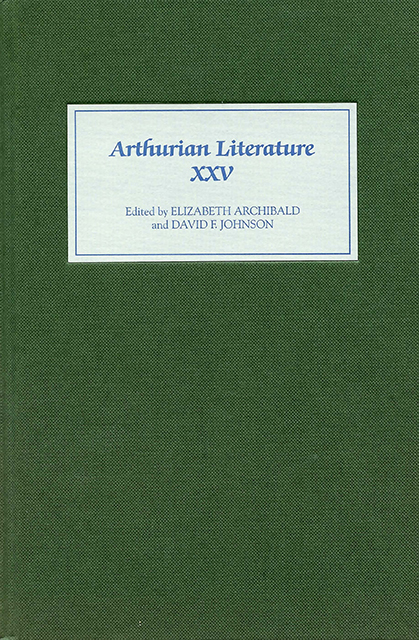Book contents
- Frontmatter
- Contents
- Illustrations
- Foreword
- Contributors
- Abbreviations
- I Geoffrey of Monmouth and the Merlin Legend
- II The Enchantress, The Knight and the Cleric: Authorial Surrogates in Arthurian Romance
- III ‘Morgan Le Fay, Empress of the Wilderness’: A Newly Recovered Arthurian Text in London, Bl Royal 12.C.IX
- IV Malory's Lancelot and the Key to Salvation
- V Chrétien in Ivory
- VI ‘An Empire of Itself’: Arthur as Icon of an English Empire, 1509–1547
V - Chrétien in Ivory
Published online by Cambridge University Press: 10 March 2023
- Frontmatter
- Contents
- Illustrations
- Foreword
- Contributors
- Abbreviations
- I Geoffrey of Monmouth and the Merlin Legend
- II The Enchantress, The Knight and the Cleric: Authorial Surrogates in Arthurian Romance
- III ‘Morgan Le Fay, Empress of the Wilderness’: A Newly Recovered Arthurian Text in London, Bl Royal 12.C.IX
- IV Malory's Lancelot and the Key to Salvation
- V Chrétien in Ivory
- VI ‘An Empire of Itself’: Arthur as Icon of an English Empire, 1509–1547
Summary
After Lancelot has lost all his hair due to a medical treatment, he desires that the hair should be put into an ivory box and sent to Guenevere. When the Queen receives the box, she is delighted and kisses it as if it were a sacred relic. Lancelot is no exception in giving his beloved lady an ivory box as a present. Luxury objects in ivory with secular images carved in low relief were often gifts from men to women as part of the rituals of courtship and marriage. In daily life, the small ivory boxes were probably used as receptacles for jewels or small objects of value. Gothic secular ivory carving flourished in Paris in the first decades of the fourteenth century. The subjects with which the ivories were carved often show courtly scenes and topics from a scope of romance literature, highlighting the glorification of true love. Adventures from Chrétien de Troyes’ Arthurian romances Perceval, Lancelot, and Yvain were carved on ivory boxes, a mirrorcase, and a writing tablet. Contemporary with the appearances on the ivory objects, these scenes were also painted in illustration cycles in Arthurian manuscripts. Were the scenes selected for the ivories obvious choices? Are they directly based on Chrétien's text? Were the same scenes illustrated in the manuscripts, and if so, are there parallels or divergences in the iconography, and what does all this tell us about the reception of Chrétien's Arthurian romances?
The Perceval Casket
Ivory caskets illustrating a single literary theme are rare. A Parisian casket dated to 1310–1330, kept in the Louvre, is the only ivory showing episodes from the beginning of Chrétien's Perceval. The story unfolds on the side panels. The cycle begins on the short left side with the encounter of Perceval with three Arthurian knights on horseback in the forest (Fig. 1). Perceval wears his ‘Welsh’ garb and a bow on his shoulder in order to symbolize the hunt. The knights, whom Perceval believes to be angels, bear flowers on their shields. This flower blazon does not feature in Arthurian heraldry, but it is typical for knights at the siege of the Castle of Love, a theme that was especially popular on the ‘composite caskets’ that will be discussed later in this article. Perceval kneels in awe in front of the knights and decides that he wants to be a knight himself.
- Type
- Chapter
- Information
- Arthurian Literature XXV , pp. 119 - 152Publisher: Boydell & BrewerPrint publication year: 2008
- 2
- Cited by

